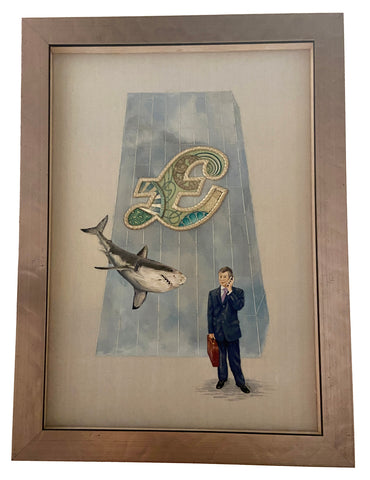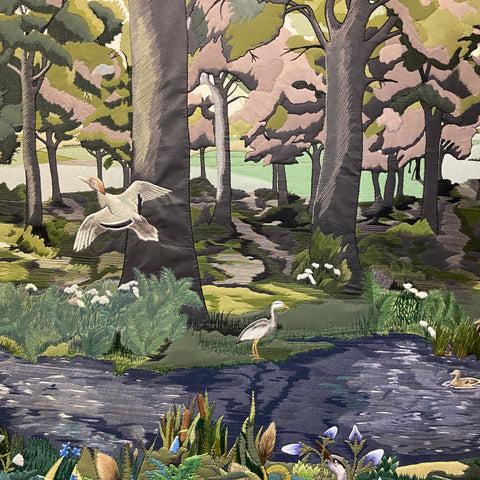Crown to Catwalk: FTM Showcases 150 Years of the Royal School of Needlework
The last time I saw Dr Susan Kay Williams she was on my computer screen talking about “poisons, poo and mad scientists” (the search for new colours in fashion) at a V&A Academy lecture. The RSN Chief Executive whose lockdown project was writing Unbroken Thread: Celebrating 150 Years of the Royal School of Needlework, has a consummate knowledge of her subject, and is an eloquent speaker, who manages to say a lot in a concise way. Unless someone asks her a question like, “What is the history of needlecraft (in Britain) before the founding of RSN?” to which her answer, though incredibly focused, could easily fill half a library of books.
Of the 120 embroidered pieces on show, very few are from the distant past, when most of the work was sold, or carried out on commission. The Royal School of Needlework was set up by women for women on 5th November, 1872, to provide teaching and a source of income for gentlewomen in need. Founders Lady Victoria Welby, Lady Marian Alford and Princess Helena (Queen Victoria’s third daughter) shared a passion for needlecraft and philanthropic causes. Their aim was to offer suitable employment for destitute middle class educated women, so they could find ways to make a living. The first students were three sisters whose father, “a surveyor of repute" died unexpectedly.

The enterprise was originally located above a bonnet shop in Sloane Street, moving from 1875 onwards to Exhibition Road, and then to Princes’ Gate where the building became a liability. When they were forced to install a net to collect pieces of plaster falling from the ceiling, their patron The Queen Mother offered the use of Hampton Court Palace on a grace and favour basis for a couple of years, before they were able to pay rent to accommodate their small staff.
The school was also the outcome of a reaction against Berlin wool work. This canvas-based needlecraft required just one stitch, and was the sort of sturdy embroidery used for bell pulls, cushions and rug edges, plus a huge number of handbags. The antidote to Berlin wool work was art embroidery, of the type typified by a William Morris and Philip Webb exhibit, featuring a peacock and vine. The esteemed RSN committee were able to attract many of the influential arts and crafts movement, including Walter Crane, whose elaborate designs for a waistcoat and four panel screen are included in the show.

At the outset no diplomas were awarded, and the best accolade any participant could expect was that they were a “good general worker” who could turn their hand to anything. The school’s year long course began in 1985 - when technical education started. Pupils were taught to work collectively on a project, so it would look as if just one person had worked on it. This remains the same to this day, as does the requirement for experts from the school to be both competent and quick. For instance, one of the dresses on display - created for Nicholas Oakwell and shown at the Shanghai 2015 Great Creative festival (and worn by Erin O’Connor in Vogue) - required a rapid turnaround. The ostrich feathers had to be sourced, and dyed in 18 shades from red to black, before they were assembled in 28 different panels - in total 200,000 ostrich fronds were used.

Royal connections led to ceremonial pieces being created, from the 1888 commemoration of Edward and Alexandra’s anniversary, to a cushion bearing the insignia of Prince Philip, which was used by ITV for programmes following his death. The height of royal approval was conferred in 1901, when Queen Victoria died and a funeral pall was required at short notice. Princess Helena promised the RSN would have it ready within 48 hours, and the stitching was carried out in 21 continuous hours by 45 women working in teams throughout the night.
Regal items on display include the mantle worn by Edward VII at his coronation 1902, the sampler for HM The Queen’s Coronation Robe of State, and several samplers made in the 1930s for other members of the royal family. There is even a layout panel showing some of the design for wedding dress of the Duchess of Cambridge, In 2011, the RSN added pieces of lace onto tulle for Sarah Burton, and oversaw the textiles used for all aspects of the Duchess’s outfit, for which the craftspeople involved were sworn to secrecy.
Another key area for the RSN was working for the military - stitch was seen as occupational therapy during World War I, as indeed it was during the pandemic. Craftwork would easily be carried out at home, and regimental badges were created in conjunction with the War Office. The church has been another major beneficiary of the school’s work, and the liturgical exhibits are among the most highly embellished on display. However, many ceremonial robes were not available, as they are still in constant use.

From 1916-1942 the RSN also had a lingerie dept, and made trousseaux for a number of royals, including Princess Alice, Duchess of Gloucester in 1935. They briefly opened a lingerie shop in Brook Street. Many of the items in this section are more than a hundred years old, yet have fortunately survived very well. They have also inspired a selection of lingerie by second year students.

Another section shows some of the old and new teaching diploma students’ work. From the 1950s, they were required to create a ‘church work piece’, which later became a ‘figure, symbol and animal’ embroidery, before it finally became totally secular. The most surprising example in this series, from 2006, shows the figure of a business man, the symbol of a pound sign, and the animal - a shark!

The upstairs part of the exhibition is largely dedicated to partnerships and student projects. The Red Dress project was conceived by Kirstie Macleod to give marginalised women around the world a platform to tell their personal stories through embroidery.


On their three year degree programme, students have to use several stitches in a variety of ways. The examples on display range from streetwear, where the gold thread embroidery would not have looked out of place a thousand years ago, to shoes designed by students and made up by Sheme, a Chinese shoe factory.
In the FTM’s workshop room is dedicated to more contemporary work by the RSN embroidery studio, including a stunning 1980s landscape embroidery, originally made for a corporate HQ. Here you will find more evidence of the effect of needlework on wellbeing, with NHS embroidered hearts. There’s a poster showing the RSN’s “stitch bank” of 200 stitches and counting… the primary aim being to keep the ancient craft alive. There are contemporary takes on old techniques like crewel work and a modern blackwork piece featuring the current royal patron - Camilla, Duchess of Cornwall.


This exhibition is not merely a review of 150 years of the Royal School of Needlework, it is also a celebration of craft skills and collaboration. From Freddie Mercury and gender fluidity, to military memorabilia, religious and royal vestments, the show has something for everyone. You don’t need to be an embroidery ambassador or a needlecraft nerd to appreciate the work that has gone into the pieces on display, the stories behind them, and the variety of stitches and techniques used. If, like me you are a curious shopper, you will also find also some charming embroidered bags and gifts in the Fashion and Textile Museum shop, alongside a display of vintage examples in the foyer.
150 Years of the Royal School of Needlework: Crown to Catwalk is at London’s Fashion and Textile Museum until 4th September, 2022.

